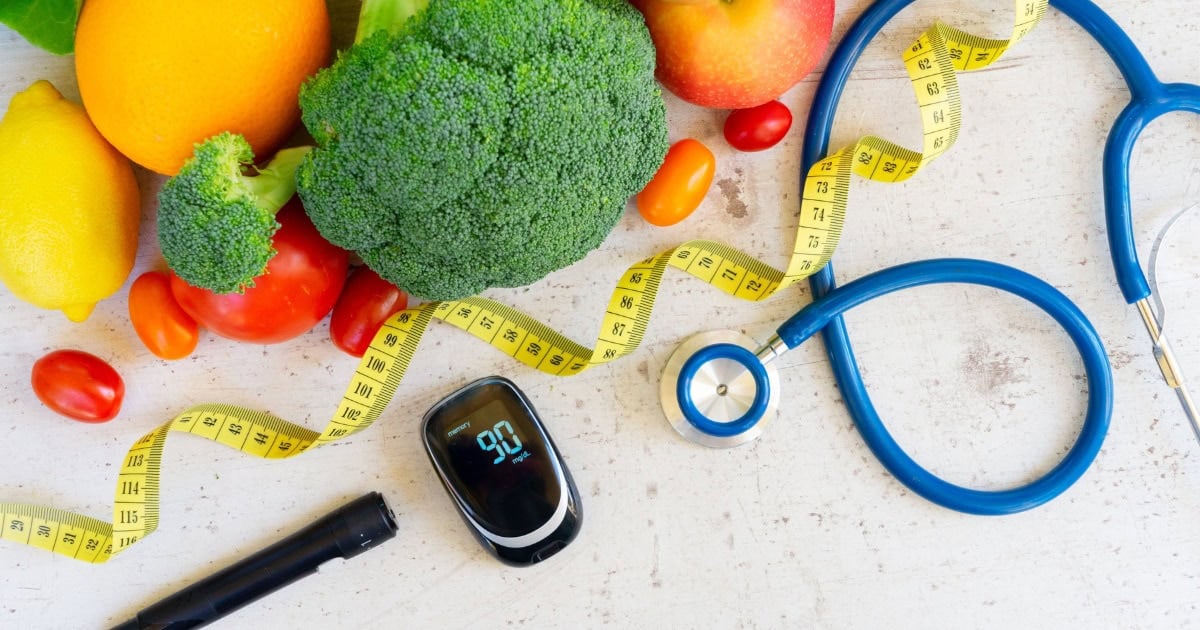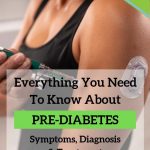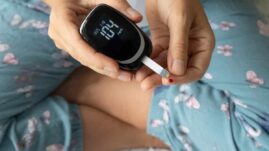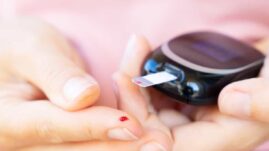Being diagnosed with prediabetes can be overwhelming, but it’s also an opportunity to take action. While it’s the earliest stage of type 2 diabetes, lifestyle changes can help improve blood glucose (sugar) levels.
This article covers the symptoms, diagnosis, and treatment options for prediabetes, and explores whether it can be reversed.

Key Points:
- Prediabetes is an early stage of type 2 diabetes, often reversible with lifestyle changes like diet, exercise, and weight loss.
- Symptoms include increased thirst, hunger, frequent urination, and fatigue, but many people are unaware they have it.
- Diagnosis is based on fasting blood sugar and A1c tests, with levels above normal but not yet high enough for type 2 diabetes.
- Risk factors include being overweight, age over 45, family history of diabetes, and lack of regular exercise.
Symptoms of prediabetes
The challenge with prediabetes is that its symptoms can be subtle and easy to overlook for years — until blood sugar levels rise enough to become noticeable.
The best way to catch prediabetes early is by scheduling regular check-ups with your doctor and requesting an A1c test (a measure of glucose management over the previous 2 to 3 months).
Like type 2 diabetes, the symptoms result from gradually rising blood sugar levels, insulin resistance, and insufficient insulin production.
Common symptoms include:
- Increased thirst
- Increased hunger
- Frequent urination
- Dry mouth
- Headaches
- Fatigue after meals
- Unexplained weight gain or loss
- Blurry vision
According to the U.S. Centers for Disease Control and Prevention (CDC), only 10 percent of people with prediabetes are aware of their symptoms, and 98 million Americans — 1 in 3 — have the condition without knowing it.
See more in: Prediabetes Symptoms: Warning Signs and How to Test.
Diagnosing prediabetes
The American Diabetes Association (ADA) defines prediabetes through your A1c, fasting blood sugar, and blood sugar 2 hours after eating:
Prediabetes diagnosis criteria
| Measurement | Range (mg/dL) | Range (mmol/L) |
| Hba1c | 5.7 percent to 6.4 percent | NA |
| Fasting blood sugar | 100 to 125 mg/dL | 5.6 to 6.9 mmol/L |
| 2 hours after a meal | 140 to 199 mg/dL | 7.8 to 11.0 mmol/L |
For comparison, normal blood sugar levels for people without diabetes are:
Normal blood sugar levels (non-diabetic)
| Measurement | Range (mg/dL) | Range (mmol/L) |
| HbA1c | Less than 5.7 percent | NA |
| Fasting blood sugar | 70 to 99 mg/dL | 3.9 to 5.5 mmol/L |
| 1 to 2 hours after a meal | Less than 140 mg/dL | Less than 7.8 mmol/L |
While the diagnosis of prediabetes is straightforward, the challenge lies in recognizing that these elevated blood sugar levels are an early warning of diabetes.
Taking action at this stage is important to prevent progression to type 2 diabetes.
Key blood tests
Fasting blood sugar: Measures blood glucose first thing in the morning, before eating, to show how your body manages glucose without food.
A1c (HbA1c) test: Reflects your average blood sugar levels over the past three months.
Higher HbA1c levels indicate more glucose in the bloodstream, which can lead to long-term damage to nerves and blood vessels, contributing to complications like retinopathy (eye damage), neuropathy (nerve damage), and nephropathy (kidney damage).
Oral glucose tolerance test (OGTT): This test measures your body’s response to sugar by checking blood glucose levels 2 hours after drinking a sugary solution.
It helps identify how efficiently your body processes glucose and is often used to diagnose prediabetes or gestational diabetes.
Learn more in: How Often Should You Test For Prediabetes?
Factors that increase your risk of prediabetes
While being overweight, inactive, or having an unhealthy diet are commonly highlighted risk factors for type 2 diabetes, the causes are more complex. There are two primary pathways that lead to prediabetes and type 2 diabetes:
Insulin resistance
This occurs when your body requires increasing amounts of insulin to manage blood sugar levels. Eventually, the pancreas can’t keep up with this demand, leading to rising blood sugar levels.
Genetic disposition
Some people have a genetic tendency toward beta-cell dysfunction, where the pancreas’ beta cells gradually stop producing adequate insulin.
For those with this genetic background, “reversing” diabetes may not be possible, but taking steps to improve overall health is still beneficial.
Key risk factors for developing prediabetes include:
- Being overweight.
- Age 45 or older.
- Having a family history of type 2 diabetes.
- Exercising less than three times per week.
- Having gestational diabetes or giving birth to a baby weighing over 9 pounds.
- Belonging to certain ethnic groups, including African American, Hispanic/Latino American, American Indian, Pacific Islander, or Asian American, all of which show a higher risk of developing type 2 diabetes.
See more in: What Causes Prediabetes?
Prediabetes treatment: how to reduce your risk of prediabetes and type 2 diabetes
Whether your risk stems from insulin resistance or genetic beta-cell dysfunction, there are many steps you can take to improve insulin sensitivity and prevent or delay the progression of diabetes.
Get moving
Regular physical activity helps burn calories and glucose, both during and after exercise.
Even a 15-minute daily walk can be a great start. Walking, although low-intensity, is effective for fat burning without increasing appetite and is gentle on the joints.
Instead of thinking, “I’m too tired to exercise,” commit to just 15 minutes of movement daily.
Make changes to your diet
Improving your diet doesn’t mean cutting out all your favorite foods. Simple changes, like eating a veggie-packed salad instead of a sandwich or reducing soda intake, can make a difference.
Start with small changes, and follow the “80/20 rule” — focus on real, nutritious foods 80 percent of the time, and allow some flexibility for indulgence 20 percent of the time.
Get more information in: Prediabetes Diet: What to Eat & What to Avoid.
“Learning moderation instead of deprivation was the hardest for me. At first, I would deprive myself of things I loved to eat because I thought that would be a quick fix. Just like any diet, it wasn’t sustainable. I learned that balancing what I wanted in moderation worked well and was much easier to maintain long-term.”
Venus Jones (read Venus’ story of reversing prediabetes)
Get more sleep
Lack of sleep negatively affects insulin sensitivity, leading to higher blood sugar levels, weight gain, and increased hunger.
Consistently getting adequate rest helps regulate insulin and blood sugar. Create better sleep habits by setting an evening alarm to remind you when it’s time to wind down.
Lose weight
Reducing excess body fat directly improves insulin sensitivity, as extra fat increases insulin resistance.
While weight loss can be challenging, especially if blood sugar levels are already elevated, steps like improving diet and increasing activity can help.
If needed, speak with your doctor about medications that can help blood sugar management during your weight-loss efforts.
Quit smoking
Nicotine increases insulin resistance, making it harder to manage blood sugar.
By quitting smoking, you can improve insulin sensitivity and lower your risk of diabetes by 30 to 40 percent. This change can have an immediate positive impact on your blood sugars.
Consider medication
For those who cannot manage prediabetes with lifestyle changes alone, medications such as metformin may be recommended.
Metformin helps lower blood sugar levels by improving the body’s response to insulin and reducing glucose production in the liver.
Speak to your doctor about whether medication is a suitable option for you.
Learn more in: Prediabetes Medication: What are the Options? and Metformin for Prediabetes: The Pros & Cons.
Can prediabetes be reversed?
For some, prediabetes can be reversed if it’s primarily due to lifestyle factors like weight gain and unhealthy habits. However, for many, prediabetes stems from the gradual destruction of beta cells, which are vital for insulin production.
Read more in: Is Type 2 Diabetes Reversible?, What is the Most Effective Way to Reverse Prediabetes?, and How Long Does It Take to Reverse Prediabetes?
Research shows that around 60 percent of people with type 2 diabetes experience beta-cell dysfunction, leading to impaired insulin production.
Dr. John E. Gerich, MD, explains in Mayo Clinic Proceedings that both insulin resistance and beta-cell dysfunction play significant roles in the progression from prediabetes to diabetes.
While making healthier lifestyle changes — such as improving your diet, increasing exercise, losing weight, and quitting smoking — can have a big impact, prediabetes for some may not be fully reversible due to genetic factors.
These changes can reduce the need for medications or insulin therapy by improving blood sugar management.
Taking action as early as possible will greatly improve your health outcomes and help manage the progression of the disease.
See more in: 10 Effective Changes You Can Make to Help Reverse Prediabetes Fast.
Did you find this article helpful? Click Yes or No below to let us know!






Alice Duffy
Thanks for posting this, it’s helped me understand more. I check my blood sugars more or less every morning and they range between 6.5 and 7.4 but I’ve been told I’m not pre diabetic. My twin had type 1 and I have an underactive thyroid plus I’ve gained so much weight, suffer from dry mouth frequently and take funny turns like feeling spaced out, shakiness and I find it difficult to talk or think. What’s your opinion on this?
Christel Oerum
Your doctor will base a pre-diabetes diagnosis on several things, often including your A1c and your fasting blood sugars. So keep going to your checkups and make sure they look at your numbers every time. If you’re overall feeling off, like it sounds like you are, you should also bring that up with your doctor so he/she can help you find a solution